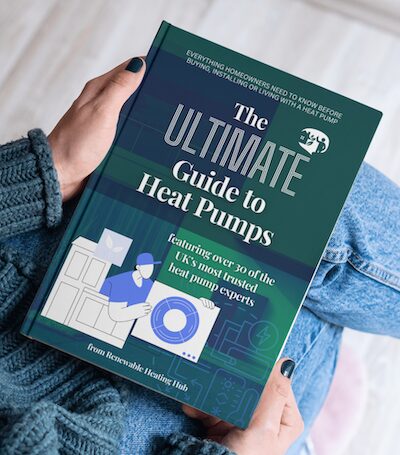Repiping and Reconfiguring our Heat Pump System Including Removing the Buffer Tank - Heat Pump Retrofix
It may be pushing 40l/min, but where is that water going, maybe through the first 2 radiators and very little to the rest?Posted by: @grantmethestrengthThe pumps on the Grants are beasts mine is on the lowest setting and still shoving 28 L/min through the system on full whack it was shifting over 40 L/min!
@adamk Where is your pump connected to? What pump valves are on the pump? What diverter valve are you using? Vibration in pipes usually comes from valves and the turbulence they cause, not from water flowing through the pipes contrary to popular belief. In Mars's system, the original primary pipework in to the building has a velocity of nearly 1.9 m/sec, and it is silent.
I did not re-pipe the system, just the plant room, all the original pipework is still being utilised.
Posted by: @heacolIt may be pushing 40l/min, but where is that water going, maybe through the first 2 radiators and very little to the rest?Posted by: @grantmethestrengthThe pumps on the Grants are beasts mine is on the lowest setting and still shoving 28 L/min through the system on full whack it was shifting over 40 L/min!
That was one of the issues we were having, the installer kept banging on that the flow rate was really impressive and that we should be amazed by his amazing install! Needless to say we turned it down to the lowest setting and we now actually get a pretty “balanced” heat throughout the house. I need to bite the bullet and get the FRVs and while they are being fitted move the two incorrectly placed rads and finally sort out the last of the leaks in the system while it is drained down! All before it gets cold, when the wife is out so I don’t get in trouble for tinkering again!
Kind Regards
Si
——————————————————————————
Grant Aerona3 13kW
13 x 435w + 13x 480w Solar Panels
Sigenergy 10kW Inverter
16kW Sigenstor battery
@grantmethestrength I am sorry you have not had an optimal service. The FRV valves MUST be installed on the return of the radiators, we had a problem at Mars's because the lockshields were installed both on the flow and returns, so it was not a simple swop out. It is a good idea, when the heat pump is running to identify the flows and returns of the radiators, prior to drain-down, it will eliminate a lot of problems later.
Posted by: @heacol@grantmethestrength I am sorry you have not had an optimal service. The FRV valves MUST be installed on the return of the radiators, we had a problem at Mars's because the lockshields were installed both on the flow and returns, so it was not a simple swop out. It is a good idea, when the heat pump is running to identify the flows and returns of the radiators, prior to drain-down, it will eliminate a lot of problems later.
Thanks for the advice Brandon, when I tried (and dramatically failed) to balance the rads last winter I noticed that on some rads the TRVs were on the “wrong”side, but as I am a rank amateur I failed to make a note of which ones so will have to measure them again. Oh well you lives and learns!
Kind Regards
Si
——————————————————————————
Grant Aerona3 13kW
13 x 435w + 13x 480w Solar Panels
Sigenergy 10kW Inverter
16kW Sigenstor battery
Posted by: @heacol@adamk Where is your pump connected to? What pump valves are on the pump? What diverter valve are you using? Vibration in pipes usually comes from valves and the turbulence they cause, not from water flowing through the pipes contrary to popular belief. In Mars's system, the original primary pipework in to the building has a velocity of nearly 1.9 m/sec, and it is silent.
I did not re-pipe the system, just the plant room, all the original pipework is still being utilised.
ok my setup is pretty simple:
7.35kw cibse heat loss
7kw Vaillant Arotherm Plus
no buffers/volumisers
250L Vaillant Heat Pump unistor tank
1 pump in the outside unit.
28mm primaries run to plant cupboard about 5m away from outside heat pump location. the interior sections between the plant cupboard and outside wall were run by my plumber as we were renovating the kitchen and, as Mars will attest i had lots of trouble getting an installer, so needed to get the ceiling up before install day. the pipes are insulated but they have been clipped using single nail plastic pipe clips to the joists. this is what my installer thinks is the cause of the low humming noise like someone left a guitar amp on. i wasnt aware primaries made so much noise and required insulated clips. if i had been told the primaries vibrated i would have run them down the side of the house outside.
i still cant believe its this reason as others have said they cant feel any vibration even when touching the primaries at the back of the HP outside. if i do a hot water run with ECO turned off the vibrations on the outside pipes before the PrimaryPro flexis is quite considerable, after the flexis its maybe half. even in ECO mode if i go in the utility which is about 4m from the entry point of the primaries i can hear the hum near the ceiling and can even feel it slightly if i touch the ceiling.. if i put my ear to the french door double glazed glass inside the house which is about 1m away from the outside unit its like a combination of white noise and the hum.
flow rate is about 750.
diverter valve seems to be a 28mm 3 port Honywell Home 272889
i dont know what to do going forward as no one wants to sort the problems out. Vaillant want to charge me probably to tell me its fine, as other installers have had similar probs with the 7KW and been told by Vaillant all good. the installer seems to want to blame the plumber. im not pulling the floors up to try and re clip the pipes.
on a side note the installer has on numerous occasions told me there sub contractor sparks would come and replace the incorrect and potentially dangerous rcd/mcbs they used due to him not knowing the Vaillant requirements.
@heacol thanks for explaining. We have FRVs on most radiators. We have TRVs in the bedrooms instead, but they are all wide open.
The temperature is pretty even throughout the house. Upstairs is about 1 to 1.5 C higher than downstairs.
I’m not sure whether that is due to the lack of FRVs, or stratification with warmer air naturally rising from downstairs. We have a wide stairwell, which enables lots of air flow between floors.
Grant Aerona 290 15.5kW, Grant Smart Controller, 2 x 200l cylinders, hot water plate heat exchanger, Single zone open loop system with TRVs for bedrooms & one sunny living room, Weather compensation with set back by room thermostat based load compensation
@grantmethestrength, if you pull the trigger on the FRVs, to get 10% off use this discount code at checkout RHHFRV10
Buy them directly from Firepower: https://www.firepowerheating.co.uk/frv
Get a copy of The Ultimate Guide to Heat Pumps
Subscribe and follow our YouTube channel!
@editor yeah i looked at those but id need 12+ for my place which would set me back £330 for the 12 pack. they look like a underfloor flow rate valve thats been attached to a standard lockshield. im going to see if i can use my thermal camera and or temp meter to balance them first. if not i might have to bite the bullet.
@adamk &@editor I think these FRVs come into their own for professional first installation use
We were very fortunate that our installer did a rough first balance (difficult when OAT was 25C!) and then came back 2 weeks later to tweak them once it was colder outside. But we know from reading the difficulties people had had and described well on this forum, that some installers don’t spend the time getting it right. Balancing ufh is slow because of the time constants.
2kW + Growatt & 4kW +Sunnyboy PV on south-facing roof Solar thermal. 9.5kWh Givenergy battery with AC3. MVHR. Vaillant 7kW ASHP (very pleased with it) open system operating on WC
It’s been an eventful few weeks, and I want to thank Richard and Chas once again for stepping in. We feel incredibly fortunate to live rurally and yet have two world-class heating engineers on our doorstep. Calm, methodical, pragmatic and meticulous, every decision they make is grounded in proper calculations and clear thinking. No guesswork, no shortcuts, just solid engineering. It took time to undo the issues, but thanks to Richard’s diagnosis and their combined expertise and dedication, we now have heating restored and, more importantly, our confidence renewed in what professionalism in this industry should look like.
This experience has reinforced just how unforgiving heat pump systems are when design and planning are treated as optional.
It has also clarified our next step: in spring we’ll be undertaking a full heat pump retrofix project. The goal is to create a proper blueprint for reconfiguring a system with microbore, long pipe runs and a large footprint. We want to show homeowners and installers not only what bad looks like, but what good looks like, and how thoughtful design, planning and calculation make all the difference.
We’ll be documenting the journey as openly as possible, because there’s no place for guesswork in this sector. This next project is about showing the right way forward so that homeowners can see it for themselves and hold their installers to higher standards.
Get a copy of The Ultimate Guide to Heat Pumps
Subscribe and follow our YouTube channel!
- 26 Forums
- 2,356 Topics
- 53.4 K Posts
- 258 Online
- 6,017 Members
Join Us!
Worth Watching
Latest Posts
-
RE: Octopus Cosy Heat Pump Owners & Discussion Thread
@kevh with the Cosy 6 I know it definitely goes to arou...
By HarrisonC , 4 hours ago
-
RE: Setback savings - fact or fiction?
@cathoderay yes I am familiar with SQL. Interesting num...
By RobS , 5 hours ago
-

Parsnip, Bacon & Coconut Milk Soup
First let me say, I am only a cook because I am human a...
By Toodles , 5 hours ago
-

RE: Controlling Daikin Altherma via P1P2 and Home Assistant
@weoleyric Oh Dear, I don’t think I am going to be of m...
By Toodles , 5 hours ago
-
RE: Electricity price predictions
Ben Watts posted on LinkedIn that he had updated this w...
By Judith , 11 hours ago
-

RE: The good, the bad and the not that great – my heat pump installation
Small update, Emailed and Spoke to Midea UK and they ...
By Burtis , 11 hours ago
-
RE: Solis S6-EH1P8K-L-PLUS – Why I Chose It and What I’ve Learned So Far
@bash Octopus does charge for the admin. The process al...
By Batpred , 11 hours ago
-
RE: External pipework insulation
@transparent HI all The products you mention are ver...
By David Smith , 11 hours ago
-
RE: New Fogstar 15.5kWh upright solution
Issues still under investigation by Solis... Fogstar ...
By Batpred , 11 hours ago
-
RE: Who's your electricity provider and what's your tariff?
I agree, the consumer is not being properly represented...
By Batpred , 11 hours ago
-
RE: Advice on internal circulation pump noise
Thanks @mikefl - I'll maybe have a look at the lock-shi...
By jtg , 1 day ago
-

RE: Heat Pump Heats the House… But It’s Not Cosy. Emitter Changes or System Tweak?
@toodles interesting suggestion, thanks. I will try to...
By GrahamF , 1 day ago
-
RE: Mitsubishi Ecodan Auto Adaption trial to stop cycling.
The interval you talk of, i think, will be 60min for an...
By F1p , 1 day ago
-
Agree with @majordennisbloodnok on the setbacks. We hav...
By ChandyKris , 2 days ago
-

RE: Speedcomfort radiator fans
@deltona the way the links were added broke the page. A...
By Mars , 2 days ago
-

RE: Refrigerant R32, is it now banned in the EU from 1st Jan 2027 for monobloc ASHPs?
This has been delayed from what I believe to be this ye...
By dgclimatecontrol , 2 days ago
-
RE: Are We Sleepwalking Into Another Race to the Bottom?
this is why I provided current flow temperatures in the...
By ksim , 2 days ago
-

RE: Why Millions of UK Homes Struggle With Heat Pumps
There's many homes that would be quite a disruption for...
By dgclimatecontrol , 2 days ago
-
RE: Ecodan unable to hit legionella target temp - what's the consensus?
@rhh2348 ...maybe this option is what you want? Alter...
By benson , 2 days ago






